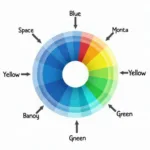The idea of a color representing stupidity is a fascinating one, raising questions about the psychology of color and how we associate hues with different traits. While there’s no single scientific answer to what color represents stupidity, exploring the cultural and symbolic meanings attached to colors can shed light on this intriguing question.
The Complex Relationship Between Color and Meaning
Colors evoke powerful emotions and associations, often rooted in cultural and historical contexts. For instance, red can symbolize both love and anger, demonstrating how a single color can carry multiple, sometimes contradictory, meanings. Therefore, assigning “stupidity” to a particular color isn’t straightforward. It depends largely on subjective interpretation and cultural influences.
Cultural Contexts and Color Symbolism
Color symbolism varies significantly across cultures. Yellow, for example, is often associated with happiness and optimism in Western cultures, yet in some parts of Asia, it can be associated with pornography or negative connotations. Similarly, while green often represents growth and nature, it can also signify envy or inexperience (“greenhorn”) in certain contexts. This illustrates the complexity of assigning a universal meaning, such as “stupidity,” to any single color.
The Psychology of Color and Perceived Intelligence
While no color inherently represents stupidity, certain colors might be perceived as less serious or less intellectual due to their associations. Bright, highly saturated colors like orange or pink are sometimes stereotyped as frivolous or childish, which some might wrongly connect to a lack of intelligence. However, this perception is purely subjective and lacks scientific basis.
Does Color Influence Cognitive Performance?
Some studies have explored how color can impact cognitive performance. For example, research suggests that exposure to the color red can impair performance on tasks requiring attention to detail. However, these studies focus on the impact of color on cognitive function, not on inherent associations between color and intelligence.
Why the Question “What Color Represents Stupidity” Is Misleading
The question itself assumes a direct correlation between a color and a complex human trait, which is an oversimplification. Intelligence is multifaceted and cannot be reduced to a single color. Furthermore, perpetuating such associations can lead to harmful stereotypes and prejudices.
Focusing on Positive Associations with Color
Instead of seeking a color that represents a negative trait like stupidity, it’s more constructive to explore the positive and inspiring qualities of different colors. Each color possesses a unique energy and symbolism that can be harnessed to create positive environments and enhance our well-being.
Conclusion: Embracing the Diversity of Color
While there’s no definitive answer to what color represents stupidity, the question itself encourages us to think critically about the complex relationship between color, culture, and perception. Instead of assigning negative connotations to colors, let’s celebrate the rich diversity of color and its power to evoke emotions, inspire creativity, and enhance our lives. Understanding the nuanced meanings of color can lead to more mindful and impactful design choices, creating spaces that truly resonate with our individual preferences and aspirations.
FAQ
- Is there a scientific consensus on what color represents stupidity? No, there is no scientific basis for associating a specific color with stupidity.
- Why do people associate certain colors with negative traits? Cultural and personal experiences influence our perception of colors and their associated meanings.
- Can color affect our cognitive abilities? Some research suggests that certain colors can impact performance on specific cognitive tasks, but this doesn’t equate to representing intelligence or stupidity.
- What are some positive associations with different colors? Blue is often associated with calmness, green with nature and growth, and yellow with happiness.
- How can we use color effectively in design? Understanding color psychology and cultural symbolism can help us create spaces that evoke desired emotions and enhance well-being.
- Why is it harmful to label a color as representing stupidity? Such labeling perpetuates stereotypes and can lead to prejudice.
- How can I learn more about color theory and symbolism? Numerous resources, including books, websites, and courses, explore the fascinating world of color.
Need support? Contact us at Phone Number: 0373298888, Email: [email protected], or visit our address: 86 Cau Giay, Hanoi. We have a 24/7 customer support team.
